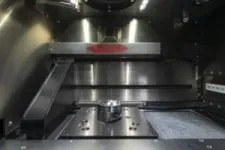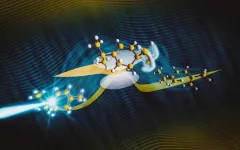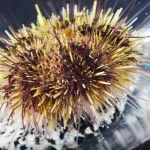(Press-News.org) Dean Pierce of the Department of Energy’s Oak Ridge National Laboratory and a research team led by ORNL’s Alex Plotkowski were honored by DOE’s Vehicle Technologies Office for development of novel high-performance alloys that can withstand extreme environments.
At this year’s Vehicle Technologies Annual Merit Review, held virtually on June 12, VTO recognized Pierce, an R&D staff scientist in the Physical Sciences Directorate, and the DuAlumin-3D research team under Plotkowski.
VTO honored Pierce, a member of ORNL’s Alloy Behavior and Design group, with a Distinguished Achievement award in recognition of his leadership in the development of the new Three Chromium-eXtreme High-Temperature Strength, or 3Cr-XHTS, steel. The steel alloy is made of chromium, which comprises nominally 3% of the material’s mass as reflected in its name, and other alloying elements.
Through the VTO LightMAT program, the ORNL team worked in close collaboration with Cooperative Research and Development Agreement partner Cummins to develop the more durable steel alloy in less than four years.
“We’ve had a great collaboration with Cummins, and working with them has allowed us to bring together the unique expertise at both ORNL and Cummins to develop 3Cr-XHTS,” Pierce said. “I was excited for our whole team that, after four years of hard work and some exciting results, we were recognized.”
3Cr-XHTS steel was created for use in pistons capable of enduring high temperatures, high stress and long periods of wear for next-generation, higher-efficiency, heavy-duty internal combustion engines. The current state-of-the-art steel alloy for heavy duty engine pistons, 4140 steel, is limited to applications where peak metal temperatures are below 500 C, making the material insufficient for use in future, higher-temperature engines.
“For the piston application, we needed to design a steel that is not only strong and oxidation resistant at high temperatures, but it also has to conduct heat well. One of the purposes for conducting heat is to keep the temperature at the combustion surface of the piston low enough so that the material doesn’t fail during operation,” Pierce said. “These properties are often in conflict with one another, meaning that when one property is improved, others can be degraded, and our team needed to overcome this metallurgical design challenge.”
The new high-strength, medium-carbon steel is optimized for superior fatigue and oxidation resistance. Compared with 4140, 3Cr-XHTS steel demonstrated a 143% increase in fatigue strength and about a 75 C increase in high-end operating temperature. The steel also demonstrated a 46% improvement in high cycle, high-temperature fatigue strength compared with H11 tool steel, another chromium-containing high-temperature alloy.
Using 3Cr-XHTS steel, researchers manufactured full-size piston crowns, engine parts that are located at the top surface of pistons and exposed to high-temperature gases and high-pressure during combustion. The new alloy successfully passed Cummins’ most rigorous engine test, a 500-hour modified peak power output test, within a six-cylinder, 15-liter heavy duty engine.
In addition to the steel’s advantageous material properties, 3Cr-XHTS steel is affordable and may potentially be a replacement for higher-cost tool steels. The alloy could have applications in various vehicle sector decarbonization efforts and is compatible with low-carbon fuels that may be adopted for heavy-duty vehicles in the future, such as natural gas, hydrogen, synthetic diesel, renewable diesel and biofuel.
At the Annual Merit Review, ORNL’s DuAlumin-3D research team received a Team Award recognizing their development of DuAlumin-3D, a lightweight aluminum alloy developed under the VTO Powertrain Materials Core Program in a joint effort with the DOE Advanced Materials and Manufacturing Office, or AMMTO. Work was performed in part at the Manufacturing Demonstration Facility at ORNL, home to the MDF Consortium, a nationwide group of collaborators working with the lab to advance the state of the art in U.S. manufacturing technology under the guidance of AMMTO.
The team began developing the alloy in response to a need for resilient, lightweight aluminum alloys that could be used in additive manufacturing, or 3D printing.
“Aluminum alloys were a really interesting problem space for us to work in,” said Plotkowski, senior R&D staff member and the project’s principal investigator. “The major challenge is that conventional wrought aluminum alloys, the ones that we use the most around the world as well as the ones that have the most attractive properties, are challenging to process with additive manufacturing.”
DuAlumin-3D overcomes this hurdle and other material problems with its extraordinary fatigue strength and creep resistance — the best creep resistance, in fact, of any known aluminum alloy at 300 C and above. The printable material was designed for use in laser powder bed additive manufacturing and can withstand AM’s extreme thermal conditions. The alloy retains more than half its strength at temperatures of 300 to 315 C, with microstructural stability up to 400 C.
DuAlumin-3D takes its name from its dual strengthening mechanisms, made possible by the rapid solidification characteristics of 3D laser printing combined with a brief heat treatment.
In less than three years, the technology evolved from a concept into its current state as a viable material for additively manufactured prototypes and products.
“It was necessary to collaborate in order to make this project happen,” Plotkowski said. “It’s, in my opinion, an example of the kind of unique thing that ORNL can do that few other organizations in the world can do because we’re bringing together this diverse skillset. We’re able to easily pull people from all across the organization to contribute.”
Using DuAlumin-3D, researchers have already printed pistons that successfully completed a severe four-cylinder engine test demonstration at ORNL in January. The team is also working alongside commercial partners, including General Motors and Honda Performance Development, to further develop the alloy for use in specific vehicle components. GM is scheduled to test a set of pistons printed from the alloy in a new lightweight, high efficiency V8 medium duty truck engine.
DuAlumin-3D could also be applicable in the aerospace sector, Plotkowski said, where a lightweight material like the new alloy could replace titanium parts to significantly reduce an aircraft’s weight and improve energy efficiency.
The ORNL team, alongside collaborators General Motors and Beehive Industries, also received a 2022 R&D 100 Award for DuAlumin-3D.
Additional team members honored include ORNL’s Amit Shyam, Ryan Dehoff, J. Allen Haynes, Larry F. Allard, Sumit Bahl, Ying Yang, Jon Poplawsky, Bill Peter, Derek Splitter and Jiheon Jun; Owens Corning’s Richard Michi, previously of ORNL; and the University of Tennessee, Knoxville’s Kevin Sisco.
UT-Battelle manages Oak Ridge National Laboratory for DOE’s Office of Science, the single largest supporter of basic research in the physical sciences in the United States. DOE’s Office of Science is working to address some of the most pressing challenges of our time. For more information, visit https://energy.gov/science. — Alexandra DeMarco
END
ORNL researcher, team received honors for advanced alloy development with industry
2023-08-02
ELSE PRESS RELEASES FROM THIS DATE:
A more holistic and efficient way of testing PPE
2023-08-02
ALBUQUERQUE, N.M. — A team at Sandia National Laboratories has developed a faster and more comprehensive way of testing personal protective equipment, or PPE. The basic principle: modeling a device to fit the human form and human behavior.
When COVID-19 hit, PPE testing became an urgent need. In March 2020, when the country went into lockdown, many people turned to Sandia for PPE testing support. They were trying to bring new masks to the market, provide quality assurance for imported masks and vet cleaning processes for reuse of single-use PPE.
“Whether using in-house or commercial filter ...
True shape of lithium revealed for the first time in UCLA research
2023-08-02
Rechargeable lithium-ion batteries power smartphones, electric vehicles and storage for solar and wind energy, among other technologies.
They descend from another technology, the lithium-metal battery, that hasn’t been developed or adopted as broadly. There’s a reason for that: While lithium-metal batteries have the potential to hold about double the energy that lithium-ion batteries can, they also present a far greater risk of catching fire or even exploding.
Now, a study by members of the California NanoSystems Institute at UCLA reveals a fundamental discovery that could lead to safer lithium-metal ...
New study: Political animosity is global
2023-08-02
EAST LANSING, Mich. – A new study by an interdisciplinary team of researchers across six different countries found that affective polarization, or the tendency to dislike people who belong to opposing political parties while favoring people from their own political party, is a global bias — not just an American one. The research further indicates that the dislike grows stronger when two people think about political issues the same way but come away with different beliefs about those issues.
For instance, two people from two separate political parties both may think that tax policy and ...
Public invited to follow Bering Land Bridge research project
2023-08-02
The public can follow a team of scientists aboard the research vessel Sikuliaq as they spend the month of August studying conditions that existed on the Bering Land Bridge during the last ice age.
The project, led by University of Alaska Fairbanks geology professor Sarah Fowell, will collect samples from beneath the sea floor to learn about the vegetation and climate of the region about 25,000 years ago.
The project team will share updates during their journey via several digital and social media channels:
Facebook
Aboard the ...
Modern antidepressants may reduce risk of relapse for patients with bipolar depression
2023-08-02
Treatment with modern antidepressants may help prevent patients with bipolar disorder from relapsing into a depressive episode, according to an international clinical trial led by researchers at the University of British Columbia.
The findings, published today in the New England Journal of Medicine, challenge current clinical practice guidelines and could change how bipolar depression is managed globally.
“Treating depression in bipolar disorder is challenging and the depressive episodes can be quite devastating for patients ...
Scientists discover mechanisms that could explain high risk of complications from lung infections in Down syndrome
2023-08-02
AURORA, Colo. (August 2, 2023) – Individuals with Down syndrome, the genetic condition caused by triplication of human chromosome 21, also known as trisomy 21, display a very high risk of hospitalization and mortality after developing lung infections. Respiratory disease is second only to congenital heart defects as a cause of death among children with Down syndrome, and lower respiratory tract pathology is the most common cause of acute hospital admissions in this population. Furthermore, adults with Down syndrome have a much higher risk of hospitalization and death from COVID-19. Despite many research efforts, ...
Scientists view the “transition state” of a photochemical reaction in real-time
2023-08-02
The Science
In chemical reactions, molecules proceed during their transformation from reactants into reaction products through a critical geometry. In chemistry, geometry refers to the arrangement of atoms in a molecule. Scientists often call critical geometry in reactions a transition state. This state has an almost incomprehensibly short lifetime of less than one millionth of one millionth of a second. Scientists recently captured a critical geometry using the ultra-high speed “electron camera” at SLAC. In combination with quantum simulations of the reaction, ...
Scientists dig into wildfire predictions, long-term impacts
2023-08-02
Wildfires are an ancient force shaping the environment, but they have grown in frequency, range and intensity in response to a changing climate. At the Department of Energy’s Oak Ridge National Laboratory, scientists are working on several fronts to better understand and predict these events and what they mean for the carbon cycle and biodiversity.
Two months into the 2023 peak summer fire season from June through August, Canadian wildfires had burned more than 25 million acres of land, disrupted the lives of millions and spread beyond the traditional confines of western Canada east to Nova Scotia. The phenomenon attracted renewed attention as smoke drifted to heavily populated ...
Sea urchins are struggling to ‘get a grip’ as climate change alters ecosystems
2023-08-02
When driving through a rainstorm, traction is key. If your tires lack sufficient tread, your vehicle will slip and slide and you won’t have the grip needed to maneuver safely. When torrential rains hit nearshore, shallow water ecosystems, sea urchins experience a similar challenge. Heavy precipitation can alter the concentration of salt in the ocean waters causing lower salinity levels. Even a slight change in salinity can affect the ability of sea urchins to securely attach their tube feet to their surroundings – like tires gripping the road. This ...
When D turns to F, quantum matter is A-plus
2023-08-02
HOUSTON – (Aug. 2, 2023) – Rice University physicists have shown that immutable topological states, which are highly sought for quantum computing, can be entangled with other, manipulable quantum states in some materials.
“The surprising thing we found is that in a particular kind of crystal lattice, where electrons become stuck, the strongly coupled behavior of electrons in d atomic orbitals actually act like the f orbital systems of some heavy fermions,” said Qimiao Si, co-author of a study about the research in Science Advances.
The unexpected find provides ...








